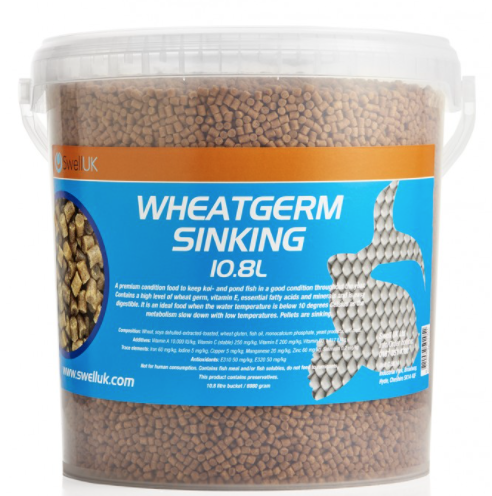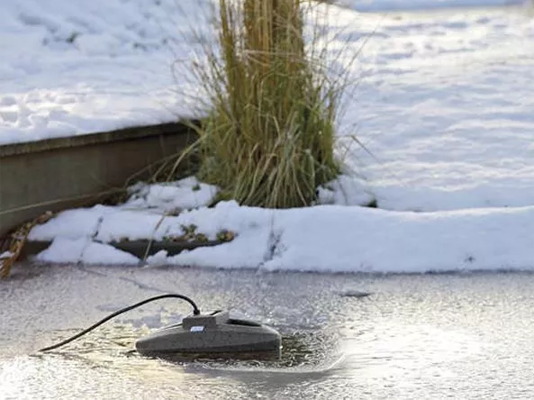10 Essential pond tasks to do this winter
Winter is a tough time for pond fish. Make sure you do your bit to get them through the winter.
1. Lower the water level
It rains much more in autumn and winter, but with cooler temperatures your pond will evaporate less. You’ll perform fewer filter cleans, and water changes too. The result is that your pond can overfill with all that rainwater, and overflow.
If you have a backwash facility on your filter, use that to pump some of the water out of the pond. At this time of year pump enough water to return the water line to about four inches from the top. This should be enough to prevent overflowing, but check on a weekly basis.
2. Clean your filter
Cleaning frequency reduces as your fish feed less and create less waste. But you don’t want leaves, muck and detritus sitting in your filter, polluting your water. Give the filter media a clean in the usual way to purge the system of mechanical waste.
3. Remove leaves
A build up of leaves can not only look unsightly on your pond surface, they also sink, fowling water and sticking to your pond pump cage. Use a fish net or pond skimmer net to remove any leaves on a daily basis.
4. Fit a cover net
A pond cover net will prevent leaves, berries and branches from falling into the water. They will also protect your fish from predation, as Herons go hungry in cold weather, and look for an easy meal.
5. Maintain your UV
Most Ultra Violet Clarifiers aren’t ice proof in severe winter weather. Check the quartz for ice damage, and in prolonged sub-zero temperatures remove the UV from the system, dry it out, and store it.
6. Move your pond pump
In freezing weather, the water at the bottom of the pond forms a thermal layer where the fish hibernate. A pond pump in the deepest part of the pond will recirculate colder surface water, especially if a water course is running, and will chill water even more.
To protect your fish, move the pond pump to a shallow level so that the pump and filter can still run, break down waste and oxygenate. The fish can then hibernate in the deep water at the bottom of the pond.

7. Change fish diet
Pond fish can’t metabolise high protein at cold temperatures, so their diet should be changed from a spring/summer one, to an autumn/winter one. When water temperatures drop to 10 Celsius, change the fish food to a Wheat Germ based diet.
When temperatures drop below 4 Celsius stop feeding altogether.
8. Buy a pond thermometer
Temperature is an important factor with all outdoor ponds. A pond thermometer will tell you water temperature at a glance, and water temperature often differs to the surrounding air temperature.
A thermometer will tell you when you need to change to a Wheat Germ diet, and it will indicate when it is too cold to move fish or add new ones. We don’t recommend adding any new fish when temperatures fall below 10 Celsius, and even then, the new fish must come from cold, outdoor water, not from an indoor pond vat, which can shock them.
9. Get a pond heater
There are several ways to help prevent ice on your pond. The best way is to invest in an inline pond heater. Consisting of a heating element and thermostat, pond heaters should be fitted inline, in a dedicated pond filtration system. Temperature can be set, and the heater will work all year to maintain that water temperature, especially in winter.
Heated winter pond water can help your fish be active, their ability to fight disease, and their immune system. It can also ensure that your fish continue to grow throughout the long, coldwater period. This is important to Koi keepers who show their fish, as maximum size is rewarded.
Not all pond heaters are that high tech however, as a simple pond heater has a heating element, a float, and needs no plumbing. It won’t heat the whole pond like an actual pond heater, but is far cheaper, uses less electricity, and is only intended to provide a small area that is free of ice. This allows CO2 to escape, and oxygen in, so its purpose is actually more for gaseous exchange than it is for heating the pond, unlike the aforementioned units above.
10. Provide an area free of ice
No pond containing fish should be allowed to freeze over entirely. When this happens the air is not allowed in or out, risking the health of the fish. An ice preventer is a single, floating device, which allows the free flow of air in and out of the water when the rest of the pond is freezing. They are the least expensive fix for a frozen pond and don’t use a power supply.









